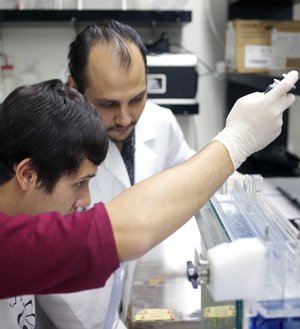Seven Steps to Building School-to-Industry Partnerships
Meeting your match for mentors, internships and expert assistance.
Collaborations with industries and professionals are a core component of career technical education. Done well, they can be a winning experience for everyone.
Students get to try out a profession to make sure it's a good fit. They learn how to conduct themselves in the business world and they make connections that may lead to future employment. Industry and business leaders get a say in developing a curriculum to make sure there's a practical focus to outfit students with the skills they'll need to get hired. As for the schools, they get seasoned professionals to advise students, arrange field trips and, sometimes, provide financial support.
While many CTE programs have developed best practices to cultivating these relationships, there are some barriers; not all academies have enough staff, budget, or time to put into a program.
Thanks to the Alliance for Excellent Education, the California Department of Education, Cesar Armendariz at USC, Joseph Cocozza at Bravo Medical Magnet High School, and Jeff Merker at Sheldon High School for their help in compiling the following tips.
1. Find Partners with a Shared Vision and Goals
Growth industries in your region have a survival stake in training the next generation of workers. That's why Chris Schuring, co-founder of Ternion Bio Industries near Sacramento, became a mentor. He wanted to help the students in the Green Energy Technology Academy (GETA) at Laguna Creek High School understand the renewable-energy industry and to give them the tools to succeed in the field. "Otherwise," he says, "there won't be anybody to take over when people like me are done."

2. Remember that Leadership Matters
Cesar Armendariz, director of community outreach for USC's health science campus, says former university president Steven Sample set the tone with his philosophy that faculty and staff didn't need to solve the problems and ills of the world, but they could make a difference in their backyard. As Armendariz explains, "President Sample made it a point that every faculty, staff, or student should, at some point, touch the life of a neighborhood student."
3. Get Creative with Money and Donations
The University of Southern California runs a United Way-type of program each fall that raises more than a million dollars a year for community partnerships like the program with Bravo Medical Magnet High School. If money is in short supply, you may consider asking businesses to provide equipment and other non-cash resources. Laguna Creek teacher Eric Johnson writes grant proposals and has a knack for getting community and industry support -- an alternative fuel company donated a $17,000 gas chromatograph (used to check the purity of biofuels) to his school's GETA academy. Across town at Sheldon High, building trades teacher Jeff Merker says lumber companies are more than happy to part with extraneous boards -- as long as the school comes and gets them. (Click here to read more about how a CTE program can be funded.)
4. Get It in Writing
It's important for all agencies and people involved to agree on the learning objectives, expectations, and time commitment for each type of partnership. What skills and knowledge should students get from an internship? How often will mentors and students meet and for how long, and is there a final project involved? What is expected of student interns in terms of behavior, attire, and responsibilities?
Many schools draft simple contracts -- no legalese needed -- that spell out each partner's expectations in a few sentences. "I will arrange for two classroom topics/speakers during the year," reads one sample employer commitment form from the Career Academy Support Network (CASN). CASN's Web site has dozens of similar examples.
5. Establish Ongoing Supervision and Communication
Even a signed contract is no guarantee of smooth sailing. Teachers need to establish regular communication with students, mentors, and supervisors at the work site. Think of it as progress reports. Is the student motivated? Is the work or project as relevant as expected? It's a continuing process of formal and informal evaluations through grades and written observations (see CASN website/link above) and checking in with each student individually.
6. Make a Commitment for the Long Haul
You can bank on it that principals and professionals will change but, with a strong commitment from all institutions and a concrete structure, academy partnerships can endure. Bravo Medical Magnet High School and the USC medical campus have been working together for some 15 years and have no plans to stop.
7. Be Patient -- It Doesn't Happen Overnight
Building effective and lasting partnerships takes time. So instead of attempting the go-it-alone route, seek out support from a respected community leader -- a member of the school board or chamber of commerce -- and ask for help in generating a buzz and lining up prospective partners. Also ask students and parents to spread the word. You never know whose brother-in-law or retired neighbor would be thrilled to mentor a student or develop an internship program at work.
Additional Resources for Internships, Mentorships, Partnerships:
Internships are an integral part of successful Career and Technical Education programs. Here are templates, guides, and contracts that you can use to build your partnerships.
Mentoring Contracts
Work Site Learning Plan
Student Internship Evaluation
Volunteer Mentor Form
Student Job Shadowing Work Schedule
Elk Grove Unified School District And Bravo Medical Magnet High School
Per Pupil Expenditures
Free / Reduced Lunch
86%DEMOGRAPHICS:
The above demographics are for Bravo Medical Magnet High School. The demographics for Elk Grove Unified School District are as follows:
26% Hispanic,
25% White,
23% Asian,
18% Black,
6% Filipino,
2% Pacific Islander,
1% Native American